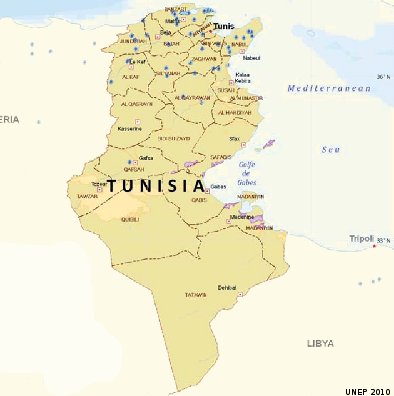Due to its geographical position and general orientation of the main relief, Tunisia is influenced in the North by the Mediterranean, the South being under the influence of the Sahara. The Center is under the joint effect of these two elements. Thus, the North of the Tunisian Dorsal benefits from a Mediterranean climate. The Center as well as the Gulf of Gabes has a semi-arid climate.
The rest of the country witnesses a desert arid climate. It shall be noted that the key position of Tunisia between the tempered regions of the Northern Hemisphere and the inter-tropical regions grant its climate a special variability. Such a characteristic makes Tunisia a country particularly vulnerable to Climate Change.
Climate change and its impact on water resources
The geographical position of Tunisia interlinking the tempered regions of the northern hemisphere and the inter tropical regions, confers to its climate an important variability Tunisia will certainly be very sensitive to the direct adverse effect of Climate Change due to its geographical location and its climatic characteristics.
In addition, faced with the threats caused by the accelerated sea level rise (ASLR), Tunisia is at risk to be more exposed and thus more vulnerable. In fact, the ASLR can have important harmful consequences on various economic sectors related to the sea or the coast line, as well as on the physical and biological coastal environment and on human settlements. Water resources constitute the most precious economic and environmental “capital” for like Tunisia largely affected by aridity.
Regarding future projections, the picture is even more gloomy, since according to a forecast after 2025, the country will be in situation of water shortage (less than 500 m3/inhabitant/year). This situation is even more alarming for Tunisia as it has the lowest level of water resources in North Africa, and which is already very close dare scarcity average.
The water resources i.e. surface waters in particular are largely dependent on climate variability and rainfall patterns. The average surface water volume available annually in Tunisia is 2700 millions cubic meters (Mm3/year). The rainfall has always been marked by dry episode sequences which is sometimes disastrous. However, this availability is highly modulated by rainfalls leading to sometime extreme cases.
Policy to combat desertification
Institutionally, climate change and all environment protection issues in Tunisia are handled by a central structure. The Ministry of Environment and Regional Development is responsible and other more specialized structures comprise institutions such as the Environment Protection National Agency, the Drainage National Office the International Center of Environment Technology of Tunis, the Coasts Development and Protection Agency, and other government bodies.
Therefore, in addition to the agricultural systems management policy, Tunisia launched for many years, an adequate policy to combat desertification. This policy has been translated by the implementation of parade strategies, comprising notably an effective mobilization of the populations in light of the land pressure, and the knowledge development and the evaluation of the desertification process.
WACDEP implementation
WACDEP focus should be to strengthen the capacity of the government institutions and programmes already in place. WACDEP can also develop activities aligning them with the government priorities for those sectors that are most severely be affected. Attention should especially be paid more in developing robust early warning systems, active management of the coastal areas and improved communication between agencies will prove requisite. The management of water resources, including investments in upgraded drainage systems and control of floods would go a long way in mitigating climate change impacts and curbing vulnerability.
